
Exchanging Fast-stirring and ISO 11451-5 knowledge in Japan
Last week, our consultants, Hanneke van Veen and Dimitrios Barakos, visited seven companies in Japan with our friends from Microwave Factory to help companies implement the closed-loop power control (fast stirring) reverb method as per the ISO11451-5 test standards.



This is Rik de Groot, holding a rare 110 CM absorber. In this post, he explains the correlation between testing frequencies and absorber height. And how tall are the longest absorbers on the market?
Rik de Groot, Managing Director of our sister company, Dutch Microwave Absorber Solutions (DMAS): “The taller the absorber, the lower the frequency you can test with it. We speak of an absorber when the reflectivity is at least -30dB, the so-called start frequency. The tallest absorber we sell is 65CM/ 26”, used for tests starting around 300 MHz, but the one in the photo is 110CM.
We do not sell these anymore since the geometry of the absorber tip has changed (javelin), but for the right application, we’re open to developing a 110cm javelin tip absorber. For example, the tallest absorbers in the market are mainly used to measure AM or FM frequencies to test onboard radio antennas on vehicles.
The downside of large absorbers is that the chamber needs to be bigger, and many clients have limited heights in their buildings. Instead, we focused on developing new, smaller size absorbers such as 65, 45, 30 and 13CM absorbers for testing between frequencies of 450MHz up to 110GHz.”